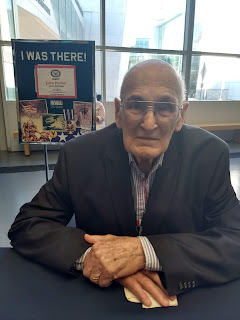But first, I'd like to share a little bit about the museum that facilitated the interviews.
National World War II Museum
Luckily for me, I live within driving distance of New Orleans, which is home to the National World War II Museum. While making a trip down to the Big Easy to see the museum would seem like a no-brainer, one reason or another had kept me from stopping by for several years. However, a couple of weeks ago, I finally got the opportunity to experience the museum first-hand.
And what an experience it was.
First off, the place is huge. The museum campus consists of no less than five buildings (with a sixth on the way!) and countless displays and artifacts to analyze. Everything from uniforms, maps, weapons, tools, and vehicles are there to be seen. It goes without saying that I was a bit overwhelmed by it all, and even after spending a full day at the museum, I estimate that I made it through only about a third of the exhibits.
However, despite the impressive scale and artifact collection, I believe that the museum's most important staples are the veterans themselves who often take the time to set up in the museum lobby and personally share their experiences with visitors. While artifacts, videos, and demonstrations are well and good, nothing beats hearing an account from someone who lived through World War II and experienced it first-hand.
For my part, I had always wanted to take the time to sit down for an interview with one of these veterans, and on the day of my visit to the National World War II, I was honored with the opportunity to speak with not one, but two of these heroes. In this post, I'll post an edited transcript of the first of these interviews, a short talk that I had with U.S. Navy Radarman 2nd Class John Clay Poche.
RDM 2-C John C Poche
 |
| RDM 2-C John Clay Poche |
Briefly tell me about where you're from and about your service experience.
I was born in Donaldsonville, Louisiana. At a very early age, we moved to Marrero, Louisiana. I was living in Marrero at the time I went into the military. I served two years, ten months, and 13 days with the Navy.
I went into the Navy because I knew if I was in the Navy I would have three hot meals every day, and a clean bed to sleep in every night.
And I was wrong! One day, and only one day, I did not have three hot meals. We were under siege by the Japanese fleet (Note: This engagement is known as The Battle off Samar, one of the most brutal naval battles of the Pacific war). We did not have the gunpower to fight with them, because all we had was one 5-inch gun, a tail gun. We did fire that gun; we scored 18 direct hits out of 115 [shots] fired (Note: 6 of the claimed hits were on the Japanese heavy cruiser Chokai).
I was in radar and we were giving radar bearings, relative bearings, and ranges to the to the tail gunner all the time. Every 30 seconds we were giving range and bearings, and they were using those range and bearing to fire at Japanese ships. It worked out real good.
The Japanese did not have radar. That was a big advantage that the American fleet had over them.
 |
| Poche's ship, the USS White Plains (CVE-66), a Casablanca-class escort carrier |
A lot of people probably ask you about your combat experiences. I want to ask you about some of your experiences where you weren't in combat. What did you and your friends do when you had spare time? Did you play cards?
I played cards. Maybe 45 minutes before my [shift] would begin, I would play cards. Sometimes for money, sometimes for bragging rights! And I liked to brag!
One time, and only one time, we were playing with the Joker, the Joker was wild, and I had the Joker, and the Queen of Spades, and I drew three cards, and I got the Ace of Spades, the King of Spades, and the Ten of Spades! A Royal Flush! I bet two dollars, and nobody called!
Did you watch any movies?
We had movies on the ship, yes we did. We had sometimes 10 movies aboard ship. They would show a movie at certain times of the day, and they would always try to show a different movie. If we ran out of movies, we would get 10 more movies (Note: I'm guessing movies would be included in the regular resupply runs) or whatever our complement was. So, we seldom ever [saw] the same movie more than one time.
What were some of your favorite movies or actors?
Franchot Tone was one. And the movie he played in, I forget what it was, I was really fascinated by the acting. It was really very good. I don't remember the movie anymore but I remember the ending.
What did you and the guys talk about? The war? What you were going to do when you got home? What your plans for the future were?
Personal experiences, more than anything else. We talked about things at home, things that were important in their life.
What's one thing that you would want people to know about your experience that maybe they didn't know, especially young people? What would you tell them?
That the Navy life is a very good life, a very good life.








